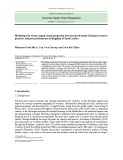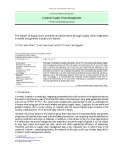
* Corresponding author
E-mail address: subburaj.a@christuniversity.in (A. Subburaj)
© 2020 by the authors; licensee Growing Science.
doi: 10.5267/j.uscm.2019.7.001
Uncertain Supply Chain Management 8 (2020) 231–240
Contents lists available at GrowingScience
Uncertain Supply Chain Management
homepage:
www.GrowingScience.com/uscm
Effects of supply chain integration on firm’s performance: A study on micro, small and medium
enterprises in India
A. Subburaja*, V.P. Sriramb and Sangeeta Mehroliaa
aInstitute of management, CHRIST (Deemed to be University), Bangalore, India
bAcharya Bangalore B-School (ABBS), Bengaluru, India
C H R O N I C L E A B S T R A C T
Article history:
Received June 5, 2019
Received in revised format June
20, 2019
Accepted July 2 2019
Available online
Ju
ly
2
201
9
The cooperation in the supply chain assumes an adequate job for enhancing an organisation's
performance and increasing competitive advantage. Supply Chain Integration (SCI) affects
organisational performance. This paper studies the impact of the integration of supply chain
procedures and practices on organisational performance and explores the effect of SCI on
organisational performance at Micro, Small and Medium Enterprises (MSMEs) in Madurai
District, Tamilnadu, India. A questionnaire is developed with validated measurement scales
from previous studies and empirical data are collected through a survey questionnaire from
250 randomly selected MSMEs. This research provides sound recommendations to MSMEs in
Madurai District, Tamilnadu, India, and maybe used for different industries and decision
making policies. Finally, the study will contribute to the scientific field by providing some
future studies.
.
, Canada
by the authors; licensee Growing Science
20
20
©
Keywords:
Supply Chain Integration
Organizational Performance
MSMEs
Customer Integration
Supplier Integration
Internal Integration
1. Introduction
Globalisation was led by advancement in communication and transportation (Ataseven & Nair, 2017).
Because of globalisation, customers' requirements and needs are changing rapidly. Buyers require
appropriate goods and services at a reasonable price and in a reasonable time with high quality and the
right place. If organisations want to compete in the new market, they should correspond with the
beforehand customers' demands (Cao & Zhang, 2011; Gimenez, van der Vaart, & Pieter van Donk,
2012). To satisfy the customers' needs, organisations should enhance all their activities and strategies.
Supply Chain Management (SCM) is a framework that enhances all processes accomplished by the
organisations (Arzu Akyuz & Erman Erkan, 2010). SCM is a complicated operation that includes all
supportive movements of vendors, suppliers to after-sales services. To have the capacity to develop
and endure any organisation needs to recognise its qualities and deficiencies and to re-enforces on
conditions and conquer weaknesses (Wong et al., 2010). Actualising SCM can be a foundation of
competitive advantages (Ou et al., 2010) which prime to better performance by and overall
organisations' performance (Danese & Romano, 2011).

232
The cooperation in the supply chain assumes an adequate job for enhancing an organisation's
performance and increasing competitive advantage. To use the supply chain at its most extreme
performance level, organisations need to incorporate their objectives and practices together (Prajogo &
Olhager, 2012; Ralston et al., 2015). The supply chain partners need to concentrate on different
components to guarantee competitive advantage: cost negotiation to increment in profit, and financial
collaboration effort to support innovative product design (Arzu Akyuz & Erman Erkan, 2010; Prajogo
& Olhager, 2012). The SCM involves integration and synchronisation for achieving and reacting to
customer request changes (Flynn et al., 2010; Govindan et al., 2015). Studies demonstrate that Supply
Chain Integration (SCI) affects organisational performance (Prajogo & Olhager, 2012; Ralston et al.,
2015; Prajogo et al., 2016). Like this, it appears that its value must be reflected to the impact of the
integration of supply chain procedures and practices on organisational performance, so this research
explores the effect of SCI on organisational performance at Micro, Small and Medium Enterprises
(MSMEs) in Madurai District, Tamilnadu, India.
The MSMEs have been contributing substantially to the extension of entrepreneurial endeavours
through business improvements. The MSMEs are broadening their domain across over parts of the
economy, delivering the differing range of products and services to meet requests of worldwide markets
(Ministry of Micro, Small and Medium Enterprises, 2018). Thus, the MSMEs performance will affect
the nation's economy. Studies also reveal that MSMEs in Madurai district are confronting numerous
difficulties and obstacles which thus influenced the overall performance at these organisations (Flynn
et al., 2010; Danese & Romano, 2011; Huo, 2012). Mostly MSMEs in Madurai district worried about
accomplishing their very own goals independently and constant changing in customer needs and
requirements because of extreme competitions among the organisations. Consequently, this leads to
challenges in integrating supply chain activities and procedures, which delay supplying products and
services to customers in the appropriate place at a reasonable time and loss of competitive advantage
(Huo, 2012).
This study aims to examine the effect of SCI on organisational performance in Madurai District,
Tamilnadu, India. This research will also give sound recommendations to MSMEs in Madurai District,
Tamilnadu, India, and for other industries. Finally, this study will contribute to the scientific field.
These days, the focus of SCI and organisational performance is to get increasingly more significance
because of its effect on an organisation's existence, steadiness, and progress. Thus, reviewing the impact
of SCI on a firm’s performance is an essential subject for organisations, and for academicians. This
study may be considered as an initiative that investigates the effect of SCI on organisational
performance at MSMEs. Subsequently, enough knowledge about the SCI in organisational
performance will enhance MSMEs performance. Outcomes of this research are critical for MSMEs, as
well as for different industries, decision makers and the academicians.
2. Literature Review
Different literature characterised SCI and supply chain performance in various ways, and every
definition was custom fitted as indicated by the idea of the study, business, and research objective. SCI
is about cooperation, collaboration and coordination among various players of the supply chain, which
upgrades an organisation's performance. The accompanying segment will handle the ideas of SCI and
supply chain performance, and the relationship between them.
2.1. Supply Chain Integration
In this study, SCI is characterised as the procedure of collaboration inside supply chain players that
oversee inter and intra-organization activities to accomplish efficient flow of products, services and
information to provide most extreme value to the customer in the right place at a reasonable cost
(Rosenzweig et al., 2003; Bagchi et al., 2005; Zelbst et al., 2009).

A. Subburaj et al. /Uncertain Supply Chain Management 8 (2020)
233
2.2 Supply Chain Integration Elements
SCM can be grouped into three dimensions to the better comprehension of SCI (Stank et al., 2001;
Zhao et al., 2008; Fabbe-Costes & Jahre, 2008). Suppliers are contemplating about the principal sources
of information and input that are required by the organisational tasks, so they have an essential job in
the continuation of assembling products and/or services to meet customer requirements (Armistead &
Mapes, 1993; Rosenzweig et al., 2003). In recent years, manufacturing organisations tend to form a
stable relationship with their suppliers to deal with the variance in demands of the customers and
lessening the production cycle time and delivery time defined by the firm and the customers (Bagchi
et al., 2005; Zhao et al., 2011; Huo, 2012). Suppliers now are progressively associated with creating
the products to promote production and remaining neighbouring to the customer (Kim, 2009; Alam et
al., 2014). Therefore, the investigation characterised supplier integration (SI) as the procedure of
cooperation among partners and organisation that encourage the distribution of data, experience,
materials and services. Correct items that redirect the purpose of the partnership, association, and
additional applicable matters among supplier and firms assessed the SI.
Internal integration (II) is the focal point of gravity for the two suppliers and customers, and it's viewed
as the essence that keeps up the stability and consistency for all supply chain parties so that the
organisation could make neither supplier nor CI without II (Wong et al., 2011; Huo, 2012; Xu, Huo &
Sun, 2014). Building the exact supply chain procedure depends firmly on the presence of clear and
shared objectives, which initially got from the acceptance of all functional divisions of the
organisational goals (Zelbst et al., 2009; Prajogo & Olhager, 2012; Huo, 2012; Govindan et al., 2015).
Within sight of such understanding, every division is thinking about two sorts of customers (Huo, 2012;
Zhang & Huo, 2013; Zhang & Huo, 2013; Leuschner et al., 2013). The primitive customer is the
preeminent client that the organisation aims to render with the finished goods or services, and the
secondary customer is different divisions or the human resources where relying on the different
outcomes to keep accomplishing their tasks and therefore the organisation can achieving the goal
(Flynn et al., 2010; Danese & Romano, 2011; Ataseven & Nair, 2017). In this study, II is determined
as the way toward keeping up cross-functional participation and collaboration inside the organisation
that means to achieve strategic organisational goals. It was estimated by a group of indicators that
identified the purpose of a link, coordination and cooperation between various departments.
The organisation is considering the customers as of the source of life, so forth organisations give either
goods or services, and it's viewed as the natural air that is required by the organisation to develop and
having the capacity to withstand in the presence of the substantial and extreme competitions (Fabbe-
Costes & Jahre, 2008; Leuschner et al., 2013). Customer needs and requirements are changed
continuously, so what was viewed as significant in the past possibly becomes complementary in near
future (Petersen et al., 2005; Mellat-Parast & Spillan, 2014). Accordingly, the organisations should
observe the external environments. Moreover, it should carry on proactively yet not reactively being
better over competitors in performing customer needs (Bagchi et al., 2005; Danese & Romano, 2011;
Yu et al., 2013). In the current study, CI is characterised as the way toward building and keeping up a
stable relationship and partnership with the customers. It incorporates sharing information, service,
outputs, and recommendations with customers. It was estimated by chosen items that investigate the
involvement and cooperation related concerns. The current research addresses the SCI, which
incorporates supplier, internal and CI.
2.3 Organisational Performance
A more extensive conceptualisation and progressively efficient performance measure should
incorporate indicators of operational performance, besides, those of financial performance
(Gunasekaran, Patel, & Tirtiroglu, 2001; Hervani et al., 2005). This is primarily because non-financial
measures can overcome the limitations of merely utilising financial performance measures. There are

234
numerous advantages on employing non-financial measures, including the facts that non-financial
measures are timelier than financial ones. The financial performance measures are increasingly
quantifiable, and they are predictable with organisation objectives and strategies (Chang et al., 2003;
Martínez Sánchez & Pérez Pérez, 2005). However, non-financial measures change and differ after some
time as market needs change and hence manage to be flexible (Gunasekaran, Patel, & Tirtiroglu, 2001;
Gunasekaran, 2004). While financial performance measures are bound to reflect the evaluation of a
firm by components outside of the organisation's limits, operational measures indicate about more
straightforwardly the effectiveness of the tasks inside the organisation (Gupta & Somers, 1996; Chang
et al., 2003). These classifications of performance reflect competencies in specific areas of the supply
chain, including cost, transportation speed and consistent quality, reliability, and customer satisfaction.
Organisational performance measures give a reasonable indication of the efforts of the supply chain
dimensions. Perceiving the significance of financial and non-financial performance, supply chain
organisation must incorporate both measurements.
2.4 Conceptual Model
Based on the above literature discussions, the framework of SCI and company performance was
developed. Mostly, the current conceptual model was modified and adapted from Huo (2012) study on
the impact of SCI on company performance: an organisational capability perspective.
Fig. 1. Conceptual Model
2.5 The hypothesis of the study
The above stated conceptual model below stated hypotheses was tested.
H01: SCI has a significant impact on the firm’s financial performance
H02: SCI has a significant effect on the firm’s non-financial performance
3. Methods
The target population of the study was micro, small and medium enterprises in Madurai district, Tamil
Nadu, India. Information about the MSMEs was collected from the micro, small and medium
enterprises (MSME) department of Tamil Nadu state government website. 29,485 MSME units of
Madurai District are registered with the MSME department. The targeted respondents for the
questionnaire were primarily chief executive officers, managing directors, owners of firms or senior
officers/executives in charge of supply chain practices in companies who would have adequate

A. Subburaj et al. /Uncertain Supply Chain Management 8 (2020)
235
knowledge of how their firms carry out their supply chain functions and how effective is their
performance. Since interviewer-administered questionnaires were used to collect the data and the
response rate for interviewer-administered questionnaires is 90%, 300 SMEs were randomly selected
for the research. After the data collection, 50 questionnaires were removed from the research due to
incomplete, biased and outlier issues. Only 250 completed cleaned data were used for calculation.
Empirical data was collected through a survey questionnaire.
3.1. Instrument Development
Based on literature review, the researcher has identified three variables that contribute to MSMEs
performance (SI, II & CI) 10 items and the total measured each variable were 30 items (from item 1 to
item 30 in the questionnaire). For instance, respondents were asked to indicate the importance of SCI
to the accomplishment of their supply chain performance, using a seven-point scale with endpoints
“Strongly disagree” (1) and “strongly agree” (7) adopted from Saleh (2015). In this study, four
dimensions are used to measure a firm’s performance. Respondents were asked to rate overall
performance using the following measures: sales growth, net profit, customer satisfaction, and order
lead time. Customer satisfaction was measured by multiple items, and the remaining three dimensions
were measured by a single item, adopted from Gunasekaran (2004), Gupta and Somers (1996). First,
sales growth was measured by sales growth rate. Second, net profit was measured regarding net profit
rate. Third, customer satisfaction was considered regarding the level of customer perceived value of
the product, the level of service systems to meet customer needs, and response time to a customer query.
Fourth, lead time was measured by a single indicator order lead-time. To provide the supply chain
managers with a broader view, each measure of the firm’s performance discussed above was evaluated
about the firm’s major competitors during three years. The criteria compared with the relative major
competitors for the last three years the response options, anchored on a seven-point scale with “1” being
“Very Weak” and “7” being “Very Strong” was adopted from Aissa Fantazy et al. (2009). The
questionnaire was developed with validated measurement scales from previous studies that examined
constructs in a query in the present study.
4. Results
It is necessary to test that the measurement model has a satisfactory level of validity and reliability
before testing for a significant relationship in the structural model (Fornell & Larcker, 1981).
Psychometric properties of the measurement model were evaluated with composite reliability (CR) and
convergent validity (Hair et al., 1998). All constructs exhibited CR with the minimum acceptable level
of 0.60, indicating excellent reliability. Fornell and Locker’s average variance extracted (AVE)
criterion is followed for the estimation of scales’ convergent validity. AVE value of a latent variable
should be higher than 0.50, to explain more than half of the variance of its indicators on average
(Malhotra & Dash, 2011; Hair et al., 1998). As depicted in Table 1, all the latent constructs (supply
chain integration) met this criterion.
Table 1
Validity and Reliability of the research scale
Dimensions
CR
AVE
MSV
MaxR(H)
1
2
3
1.
Supplier integration
0.912
0.512
0.069
0.923
0.716
2.
Internal integration
0.910
0.505
0.030
0.916
0.172*
0.711
3.
Customer integration
0.921
0.541
0.069
0.934
0.264**
0.072
0.735
Note: *p<0.05; **p<0.01
Table 1 concludes that all Composite Reliability (0.7) and convergent validity approach was used and
it shows that Average Variance Extracted values (0.5) for all construct are higher than normal levels.
It supports Composite reliability and convergent validity of the constructs. Table 1 also shows that











![Sổ tay Hướng dẫn phát triển chuỗi cung ứng [Chuẩn nhất]](https://cdn.tailieu.vn/images/document/thumbnail/2025/20251007/kimphuong1001/135x160/26201759828896.jpg)

![Bài giảng Logistic: Kho công cộng [Chuẩn Nhất]](https://cdn.tailieu.vn/images/document/thumbnail/2025/20250926/duyaokij2004@gmail.com/135x160/37761759129622.jpg)



![Bài giảng Mô hình và thiết kế hệ thống Logistics [chuẩn nhất]](https://cdn.tailieu.vn/images/document/thumbnail/2025/20250919/kimphuong1001/135x160/30911758252266.jpg)

![Trắc nghiệm nghiệp vụ giao nhận và khai báo hải quan [mới nhất 2024]](https://cdn.tailieu.vn/images/document/thumbnail/2025/20250916/dngapr1187/135x160/69491758016420.jpg)

![Bài giảng quản lý chuỗi cung ứng: Cung ứng và mua hàng [chuẩn nhất]](https://cdn.tailieu.vn/images/document/thumbnail/2025/20250915/nguyendinhdanhbgg2005@gmail.com/135x160/67081757989489.jpg)
![Đề thi Quản trị Logistics và chuỗi cung ứng quốc tế học kì 2 năm 2024-2025 có đáp án [Mới nhất]](https://cdn.tailieu.vn/images/document/thumbnail/2025/20250915/kimphuong1001/135x160/59591757927414.jpg)



